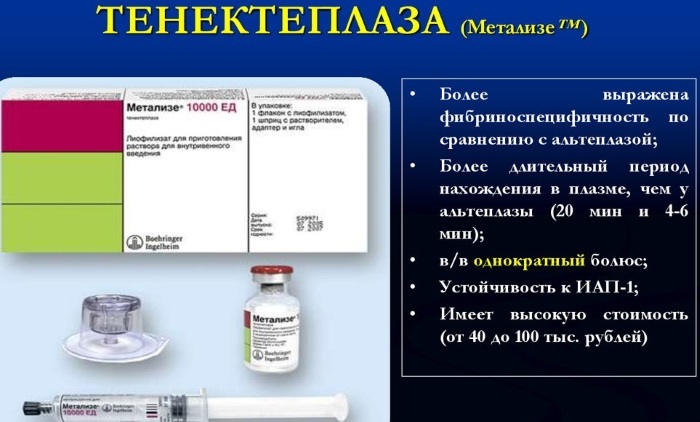Enalapril remedy refers to antihypertensive medications. Before starting therapy, they are advised to read the instructions for it, as well as reviews of patients who took the drug, in order to understand whether it is suitable or not.
Record content:
- 1 Terms of dispensing from pharmacies, drug price
- 2 Compound
- 3 Action on the body
- 4 Who is appointed
- 5 Who is contraindicated
- 6 Dosage rules
- 7 Reception scheme
- 8 Precautionary measures
- 9 Drug compatibility
- 10 Storage conditions and periods
- 11 Analogs
- 12 Video about Enalapril
Terms of dispensing from pharmacies, drug price
Enalapril belongs to the prescription list. The cost of the drug can vary significantly depending on the dosage, manufacturer, pharmacy margin.
Enalapril (reviews of patients who took the drug, most often give information about the low price for it) has an approximate cost in rubles: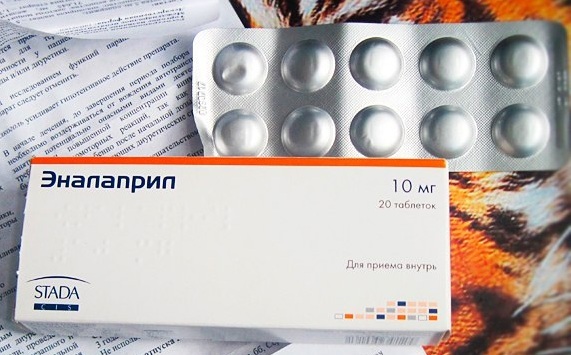
| City | Enalapril 20 mg Ozone Pharm LLC | Enalapril 5 mg by Hemofarm LLC | Enalapril 10 mg OJSC Borisovsky ZMP |
| Moscow | 22 | 54 | 12 |
| St. Petersburg | 25 | 59 | 14 |
| Ufa | 21 | 53 | 11 |
| Nizhny Novgorod | 22 | 61 | 12 |
| Ekaterinburg | 23 | 58 | 19 |
| Samara | 29 | 51 | 14 |
| Vologda | 24 | 57 | 16 |
Compound
The drug is available in tablets for oral administration. As a therapeutic component, they can contain 5, 10 or 20 mg of enalapril. The drug is produced by several companies, therefore the composition of its inactive components may differ, therefore, which additional substances are contained in the medication need to be clarified in the official instructions.
Action on the body
Enalapril refers to antihypertensive drugs that suppress ACE activity. This enzyme is responsible for the synthesis of angiotensin II from angiotensin I. All this provokes a decrease in the production of aldosterone, a decrease in OPSS, blood pressure, post- and preload on the heart muscle.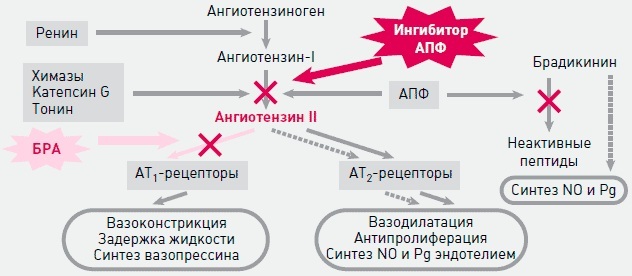
The drug prevents the decomposition of bradykinin, increases the biosynthesis of prostaglandins, dilates more arteries than veins, but it does not increase heart rate. Enalapril increases blood flow to the kidneys and heart.
If you take the medication for a long time, then it reduces left ventricular hypertrophy, slows down progression of CHF, improves blood flow in the ischemic area, has a positive effect on the lipoprotein fraction, weakens Na delay symptoms+ and water in the body.
Enalapril has a mild diuretic effect, prevents the occurrence of glomerulosclerosis and chronic renal failure.
After taking the pills, blood pressure decreases after an hour, reaches its maximum after 4-6 hours and remains low for up to a day. Sometimes, for blood pressure to reach optimal values, several weeks must pass after the start of therapy. In chronic heart failure, positive dynamics is observed after at least six months of taking the medication.
The medicine can be drunk to prevent the onset of symptoms of heart failure in people with asymptomatic left ventricular dysfunction.
Who is appointed
Enalapril is recommended for the following pathologies:
- hypertonic disease;

- chronic heart failure.
Who is contraindicated
Enalapril (reviews of patients taking the drug indicate that most are attentive to the recommendations on the use of the drug) has a number of contraindications and negative effects, which manufacturers warn about in instructions.
The medication should not be taken if you have the following health problems:
- intolerance to the composition of tablets and other ACE inhibitors;
- congenital or unexplained Quincke's edema;
- recent kidney transplant;
- cardiogenic shock;
- hemodynamically significant stenosis.
In combination with aliskiren, an antihypertensive agent should not be taken by people suffering from diabetes mellitus or kidney dysfunction, when the glomerular filtration rate is less than 60 ml per minute.
Enalapril is secreted during breastfeeding, so it is recommended to transfer the baby to the formula.
The drug is prohibited to drink during pregnancy, as it can cause a miscarriage, death of a newborn, or the appearance of he has congenital pathologies, including underdevelopment of the bones of the skull, kidney dysfunction, decreased blood pressure, contractures of the arms and legs.
Enalaprilu in its annotation contains information that it can cause unwanted reactions.
Reviews of patients who took the drug confirm this and most often indicate the following phenomena:
- suppression of bone marrow hematopoiesis, anemia, a decrease in the number of leukocytes and platelets;
- swollen lymph nodes;
- autoimmune pathologies;
- decrease in blood sugar levels;
- dizziness, headaches, depression, impaired consciousness and sensitivity, sleep problems, excessive excitability, unusual dreams;
- ringing in the ears, blurred vision;
- drops in blood pressure, loss of consciousness, chest pains, arrhythmia, angina pectoris, heart palpitations, myocardial infarction, cerebral blood flow disorder, Raynaud's disease;
- cough, dyspnoea, runny nose, sore throat, loss of voice, narrowing of the bronchial lumen, bronchial asthma, pulmonary compaction, eosinophilic pneumonia, hypersensitive interstitial pneumonitis;
- nausea, indigestion, abdominal pain, taste perversion, intestinal obstruction, inflammation pancreas, vomiting, lack of stool and appetite, dry mouth, inflammation of the gums, stomatitis, peptic ulcer;
- allergy;
- liver dysfunction;
- temperature increase;
- joint and muscle pain;
- angiitis;
- inflammation of the joints and muscle tissue;
- serositis;
- photosensitivity;
- kidney dysfunction, the appearance of protein in urine;
- erectile dysfunction;
- enlargement of the mammary glands;
- an increase in the level of potassium in the body and a decrease in sodium;
- an increase in the level of creatinine, bilirubin and uric acid in the body;
- enhancing the activity of liver enzymes;
- impotence.
Dosage rules
The dosage regimen for each person is selected individually, depending on the diagnosis, the severity of the clinical picture.
The daily dosage can vary from 2.5 to 20 mg. The maximum daily dosage should not exceed 40 mg, with the exception of patients with renovascular hypertension, they should not drink more than 20 mg of the medication per day.
The first time, until the pressure returns to normal after taking the pills, the person should be under the supervision of doctors.
If necessary, the daily dosage for hypertension can be increased every 7-14 days by 5 mg, and with CHF every 3 or 4 days by 2.5-5 mg.
If a person drinks diuretics, then 48-72 hours before starting treatment with an antihypertensive medication, they must be canceled. When this is not possible, the starting daily dosage of enalapril should not exceed 2.5 mg.
If the patient is found to have Na+ in the blood is less than 130 mmol / l or the creatinine content is more than 0.14 mmol / l, then the initial daily dose should also be no more than 2.5 mg.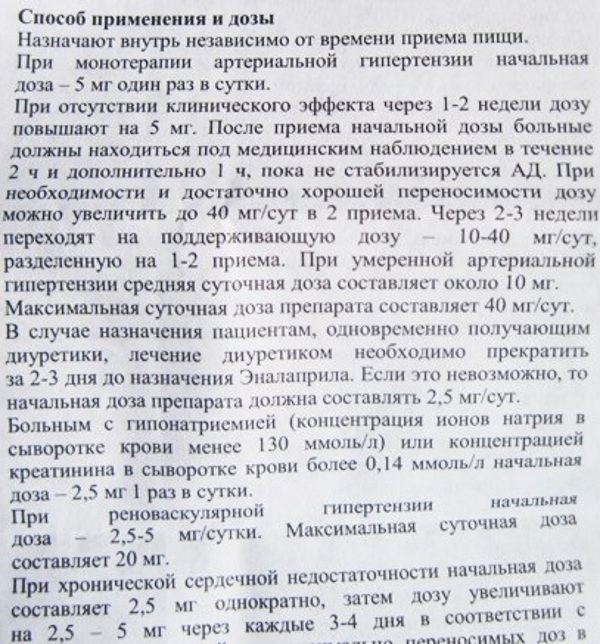
As a rule, the doctor selects the daily dosage of the medication within a month.
With an increase in the therapeutic dose, signs of enalapril poisoning may appear, such as:
- severe hypotension;
- myocardial infarction;
- stroke;
- thromboembolism;
- increased heart rate and breathing;
- shift of water-salt balance;
- kidney dysfunction;
- decrease in heart rate;
- dizziness;
- anxiety;
- convulsions;
- cough;
- complete immobilization with a weakening of the reaction to external stimuli, including pain.
If an overdose develops, the victim should be laid down and raised his legs. He is advised to rinse the stomach and give enterosorbent to drink. In severe cases, procedures are performed that help to raise blood pressure: saline, plasma substitutes, catecholamines are injected intravenously.
In case of poisoning with an antihypertensive agent, hemodialysis is effective. If bradycardia cannot be eliminated, then a pacemaker is placed.
Reception scheme
According to the instructions for use, Enalapril must be taken regardless of food, at the same time. If the next dosage of the medication is missed, you must take it as early as possible, but you cannot double the dose.
Precautionary measures
Enalapril (reviews of patients taking the drug sometimes indicate the need to take into account a history of diseases) with caution should be taken by the following categories of patients:
- If, due to the treatment, the pressure has greatly decreased, then you need to take a horizontal position. Saline infusion may be given when needed.
- If, after taking the pills, passing hypotension is observed, then there is no need to interrupt therapy. Sometimes it may be necessary to reduce the dosage of the antihypertensive agent.
- In individuals whose renal blood flow rate is less than 80 ml per minute, the level of potassium and creatinine in the blood should be checked constantly.
- In people with kidney dysfunction, it may be necessary to reduce the dosage or increase the time interval between taking the antihypertensive drug pills.
- If a person is diagnosed with narrowing of both renal arteries or an artery of a single kidney, then it is possible due to the intake of enalapril, an increase in nitrogen-containing substances in the blood, but after the completion of treatment, everything comes to the norm.

- An increase in the level of creatine and urea is possible if you drink an antihypertensive agent in combination with diuretic medications. In this case, you may need to reduce the dosage of enalapril and / or diuretic. Also, the doctor can cancel these groups of drugs.
- People with narrowing of the kidney arteries are more likely to have a drop in blood pressure and kidney failure. Kidney problems can be indicated by a slight increase in creatinine in the body. Therefore, in people of this group, treatment should be started with 2.5 mg of enalapril per day under the supervision of medical workers, gradually selecting the dose of the antihypertensive agent. They definitely need to check the level of creatinine in the blood during the entire course of therapy.
- As a rule, with liver dysfunction, adjustment of the therapy regimen is not required.
- If signs of liver damage appear on the background of treatment, it must be interrupted.
- If a person has connective tissue pathologies, or he receives immunosuppressants, allopurinol, procainamide, and especially if he still has impaired function kidney, then the antihypertensive agent must be taken with caution, since the risk of developing bacterial diseases that cannot be treated increases antibiotics. Such people should go to the hospital at the first symptoms of infection.
- At any stage of therapy, the patient may develop Quincke's edema, which requires immediate cancellation of Enalapril tablets and seeking emergency help. A person should be under the supervision of specialists until his condition returns to normal. Quincke's edema can sometimes be fatal. Patients of the equatorial race have such a severe allergic reaction more often than people of other races. There is also a high probability of developing Quincke's edema in patients who, while taking an ACE inhibitor, are being treated with drugs containing bee venom. Therefore, this combination is unacceptable.
- If LDL-apheresis is recommended to the patient, then it is worth refusing to take an ACE inhibitor, otherwise the likelihood of anaphylactoid reactions increases.
- There is a risk of Quincke's edema in people who are attached to the "artificial kidney" apparatus using high-flow polyacrylonitrile membranes. In this case, or it is not necessary to use membranes AN69 or enalapril.
- Patients receiving concomitant treatment with hypoglycemic drugs and ACE inhibitors should carefully monitor the level blood sugar during the first month of taking Enalapril tablets, as there is a risk of a drop in glucose in the body.
- While taking an antihypertensive drug, you may experience a cough, which is usually dry. After the cancellation of therapy, it goes away, but it must be differentiated from the cough that occurs with other diseases.
- A patient who is to undergo surgery should inform the doctor about taking Enalapril tablets, as there is a risk of a strong decrease in pressure due to the use of general anesthetics.
- During therapy, it is necessary to periodically check the level of potassium in the blood, since hyperkalemia can cause arrhythmias, including fatal ones.
Enalapril (reviews of patients taking the drug indicate that it causes dizziness, weakness and fall pressure) must be taken with extreme caution when driving a car and when working with potentially dangerous mechanisms.
Drug compatibility
While taking Enalapril, you need to remember the following:
- When taken in combination with the antihypertensive agent cyclosporine, potassium-containing products and medicines, as well as diuretics that delay K+ it is necessary to control the level of potassium in the blood.
- If diuretic drugs are taken against the background of treatment, then due to dehydration and a decrease in the volume of circulating blood, a strong drop in pressure can be observed. In this case, either a diuretic should be noted or the dosage of an antihypertensive drug should be reduced or the amount of salt intake or the volume of circulating blood increased.
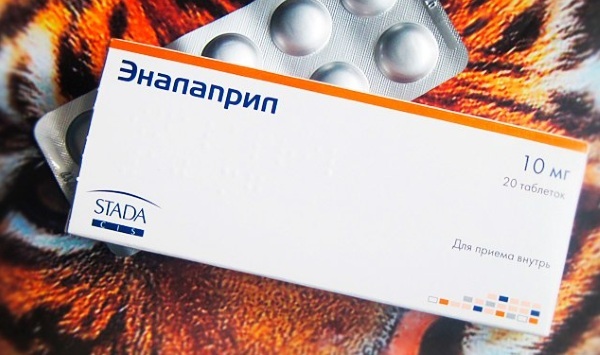
Enalapril - When taken in combination with enalapril of other antihypertensive drugs, a stronger decrease in blood pressure is possible.
- Enalapril inhibits the elimination of lithium from the body, which can lead to lithium poisoning.
- Tricyclics, antipsychotics, medications that are used for general anesthesia increase the likelihood of a strong decrease in pressure if they are used in combination with enalapril.
- NSAIDs can weaken the effects of antihypertensive drugs, and can also cause an increase in the level of potassium in the body, which can lead to a deterioration in kidney function.
- When administered intravenously against the background of treatment with gold preparations, the face may turn red, pressure drop, and nausea and vomiting may appear.
- Adrenomimetics can weaken the effect of enalapril.
- When prescribed against the background of therapy with antihyperglycemic drugs, it may provoke a decrease in blood sugar, especially at the beginning of treatment in people with kidney dysfunction.
- Ethyl alcohol enhances the antihypertensive effect of an ACE inhibitor.
- When administered in combination with an ACE inhibitor allopurinol, immunosuppressants, cytostatic agents, the likelihood of a decrease in the level of leukocytes increases.
- Antacid medicines can impair the bioavailability of ACE inhibitors.
- Enalapril reduces the effect of theophylline.
- If, against the background of therapy, agents are used that affect the RAAS, then it is necessary to check the level of salts in the body and the function of the kidneys.
Storage conditions and periods
The terms and rules for storing Enalapril tablets need to be clarified in the annotation, since, depending on the specific manufacturer, they can differ significantly.
Analogs
The following analogs of Enalapril tablets are commercially available:
-
Berlipril. This is a German drug that comes in tablets. They can contain 5 mg, 10 mg or 20 mg of enalapril.

- Ednith. This is a Hungarian medicine, which is a complete analogue of Enalapril. But it is also available in addition to tablets of 2.5 mg.
It is not enough to read the reviews of the patients who took it to the drug Enalapril, as well as the annotation to it. The doctor should prescribe it, since it is a prescription drug.
Video about Enalapril
Malysheva about enalapril:



